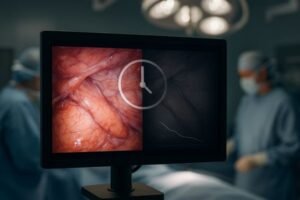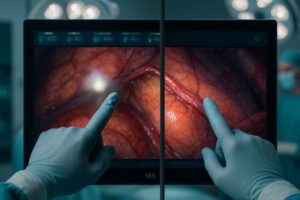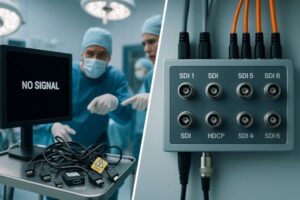In a surgical operating room, the lead surgeon is using tiny instruments less than 3mm wide. Suddenly, the image of a blood vessel on the screen lags by 0.1 seconds. This brief delay can cause a microscopic error—similar to missing the target by the width of a human hair.
This is a real challenge in modern minimally invasive surgery. The real-time delay in an endoscopic display system is not just about image quality; it directly affects patient safety. Latency is one of the key factors that impact surgical quality. If the delay is too high, the surgeon’s actions will not match the screen image, increasing the risk of mistakes.
To ensure smooth surgical procedures, the real-time delay of an endoscopic monitor should be less than 50ms. But why is this limit so important? Let’s explore the reasons in detail.
What Is Real-Time Delay in a Monitor?
Before discussing how delay affects surgery, we first need to understand the concept of real-time delay. This refers to the time difference between when a video signal enters the monitor and when the image finally appears on the screen.
For endoscopic surgery, this process involves several steps, including:
- Capturing the image – The endoscope camera records real-time images and sends them to the processing unit.
- Processing the image signal – The system improves the video quality with color adjustments, noise reduction, and other enhancements.
- Transmitting the signal – The processed video is sent to the monitor through a wired or wireless connection.
- Displaying the image – The monitor receives the signal, processes it, and shows the image on the screen.
If any of these steps take too long, the final image will be delayed, which can affect the surgeon’s precision during the operation.
Why Must the Delay of Endoscope Surgery Screens < 50 Milliseconds?
1,Human Eye’s Perception of Delay
The human eye’s ability to notice image delay depends on the situation. Usually, [if the delay is less than 30ms,](https://reshinmonitors.com/surgical-display-latency-glass-to-glass-50ms/ “if the delay is less than 30ms,”) people hardly notice it. But when the delay reaches more than 50ms, doctors doing fast movements may feel that the image does not match their actions. This can cause discomfort and affect the accuracy and speed of surgery.
For normal video watching, even a delay of over 100ms does not cause big problems. However, in endoscopic surgery, doctors rely on the screen to operate in real-time. Every second is important for making decisions and taking action. That is why delay must be kept very low in such surgeries.
2,Requirements for Hand-Eye Coordination
The success of endoscopic surgery relies on hand-eye coordination. In traditional open surgery, doctors can directly see and manipulate tissues. However, in endoscopic surgery, doctors can only view the surgical area through a monitor. Therefore, the synchronization between the screen and hand movements is crucial.
If the delay is too high, there will be a time difference between the doctor’s visual feedback and their actual actions, leading to:
- Hand movements not matching the visual information, increasing the risk of mistakes.
- Needing extra time to adjust to the delay, which can lengthen the surgery time.
- Decreased precision in delicate tasks like stitching or stopping bleeding.
Scientists at Johns Hopkins University have discovered (Surgical Endoscopy, 2018) that surgeons’ hand-eye coordination has specific time limits. If these limits are exceeded, it can affect how well they perform during surgery.
Here’s a simple breakdown of how it works:
| Part of the Process | Time Limit | What Happens if It’s Too Slow? |
|---|---|---|
| Processing Visual Signals | 13-40ms | Movements become out of sync |
| Nerve Signal Travel Time | 2-5ms | Body feedback is delayed |
| Movement Correction Time | 50-80ms | Mistakes can start to add up |
If the delay on the screen is more than 50ms, the surgeon’s ability to correct their movements doesn’t match up with what they’re seeing. This can make their actions less precise by up to 23%
Think of it like playing a video game with a slow controller – if the game doesn’t respond quickly enough, it’s harder to play well. In surgery, this “slow response” can be much more serious because it’s about someone’s health and safety.
3,Dealing with emergencies during surgery
During surgery, doctors need to react quickly to unexpected situations. For example, in an endoscopic surgery, if the patient suddenly has heavy bleeding, the doctor needs to quickly find the bleeding spot and stop the bleeding. If the monitor has a high delay, the doctor might miss the best time to stop the bleeding because the image is delayed, which could increase the risk of the surgery.
Let’s say the monitor delay is 100ms. This means the doctor’s actions are always 0.1 seconds behind the real situation. In high-risk situations, this small delay can be the difference between life and death for the patient. Therefore, keeping the delay low is very important for the safety of the surgery.
How to achieve low latency display?
1,Choose high-performance display technology
Currently, medical-grade monitors usually use LED (liquid crystal) or OLED (organic light-emitting diode) technology. Compared to traditional LCD, OLED has faster response times and lower delay, which can better meet the needs of surgeries. In addition, monitors with high refresh rates (such as 120Hz or higher) also help reduce input delay and improve smoothness.
| Module | Allowed Delay | Implementation Technology |
|---|---|---|
| Image Sensor | ≤8ms | Global Shutter CMOS |
| Signal Processor | ≤12ms | Hardware-level 3D Noise Reduction |
| Transmission Interface | ≤5ms | HDBaseT Protocol |
| Display Screen | ≤25ms | Medical-grade OLED |
3,Use high-speed signal transmission interface
To reduce the delay in data transmission, high-speed interfaces like HDMI 2.1 and DisplayPort 1.4 can provide faster signal transfer, ensuring the screen updates in real-time. Additionally, avoiding low-speed wireless transmission methods is important to prevent adding extra delay.
4,Increase the monitor refresh rate
Generally, a 60Hz monitor displays each frame in 16.67 milliseconds (ms). If the refresh rate is increased to 120Hz, the time for each frame drops to 8.33ms, which can effectively reduce input delay. Therefore, using monitors with high refresh rates and low response times is one of the effective ways to reduce delay.
Protecting life in the time dimension
The real-time delay of endoscopic surgery monitors is a key factor affecting surgical success and safety. Delays over 50ms can cause doctors’ actions and visual information to be out of sync, raising the risk of errors, reducing precision, and even endangering patients in critical moments. For this reason, the medical industry requires surgical monitors to have delays below 50ms. This isn’t just a technical standard—it’s a practical expression of respect for life. When surgeons work at the cellular level, even a millisecond of delay in the display system can determine whether tissues survive. As minimally invasive surgeries push the limits of what’s possible, the extreme focus on real-time performance is essentially a return to medicine’s core purpose: using technology to protect the fundamental dignity of human life.



